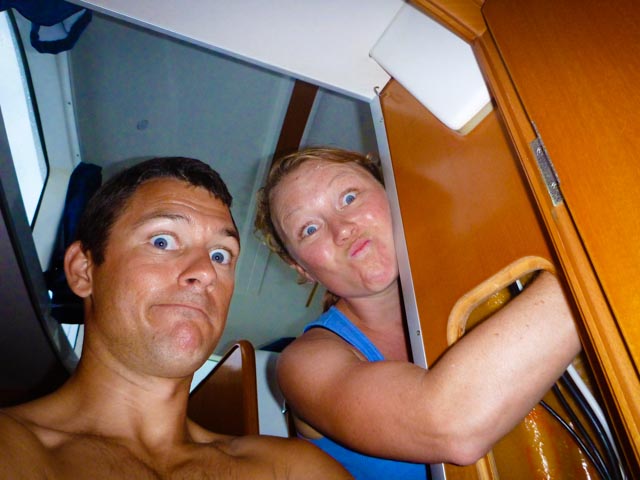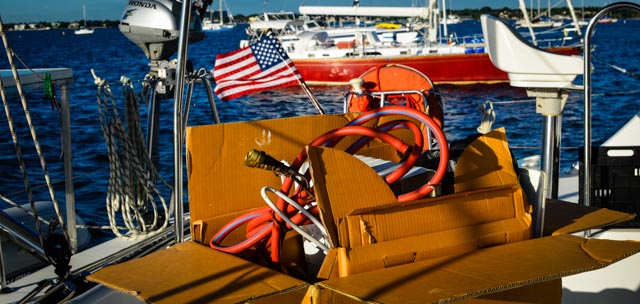Author: Miranda
Well, there has been some play. But mostly work…
It’s fun to get yourself all worked up into some good melodrama sometimes, but let’s be honest. Yes, we’ve been working our tails off lately, but we also took a few days off to entertain our first visitors aboard, and the respite was really nice. I like to be cheeky, but, don’t worry, we are far from turning into this:
Why don’t I quit the shenanigans and just begin…
We’ve been in Fort Lauderdale for about two weeks. We’ve made to-do list upon to-do list, checking off everything only to start the next day with a fresh list of new items to take care of.
After arriving in the mooring field here, we quickly met our neighbors and realized that tossing ideas around with other sailors is the absolute best way to bring our lowly ignorance up several notches in the “sailboat refit” school of hard knocks. We found a friend who runs a side-business in sailboat electrical systems, and we invited him aboard to give us an energy audit. He hooked up his multimeters and took readings on exactly how much energy we are using and how much our solar panels currently provide. Like in most boats, our refrigerator is the energy hog aboard, taking up 80-90% of our energy use.
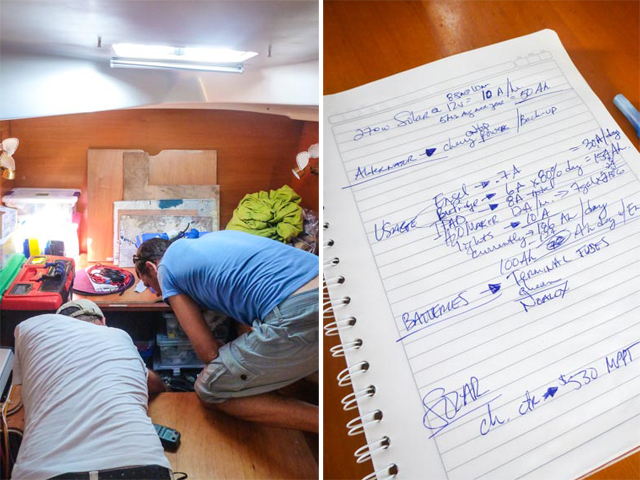

So, after looking at the numbers, Pete and I have made it our goal to become energy neutral. We want to create 100-125% of our energy usage using solar and wind power, so we don’t need to rely on running the engines (and using fossil fuels) to create enough energy for our lives aboard. Instead of going out and buying a whole bunch of new solar panels and a fancy wind generator right away, we started attacking this goal by making better use of the equipment we already have onboard. We purchased a new and very energy-efficient refrigerator compressor from Engel and we also bought a top of the line Outback MMPT charge controller for the solar panels. The charge controller works to monitor the voltage we are creating with the solar, and convert it to the 12volts that our batteries can handle, but it does this in a way that best utilizes any extra voltage we are creating, over the 12v that our batteries can handle. Instead of burning off any extra energy we might have at any given moment (like our old device would do), this new controller converts this excess to something different, by cycling between more amps/less voltage and less amps/more voltage, and is still able to make use of this excess energy instead of wasting it.
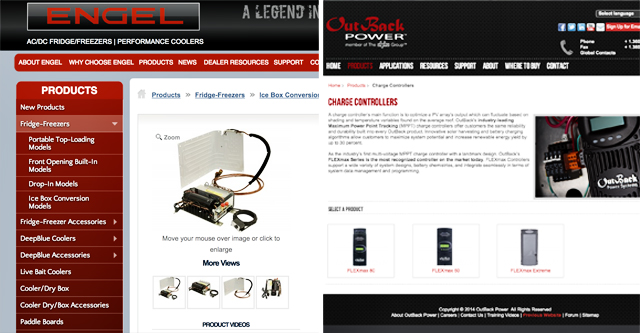
While Pete worked to understand how our electrical systems work, I set out to get our single-sideband radio (SSB) up and running. The SSB radio is basically the marine equivalent to the ham radio, which saw its heyday in the 60s and 70s. When you are thousands of miles offshore, the SSB radio is really the only way to communicate with land, other than using satellite phones, but there’s no monthly plan or minutes to buy. It’s also our plan to use the SSB to get our daily weather reports while offshore. These babies haven’t really advanced all that much since the 60s, and since you’re bouncing your radio waves off the earth’s ionosphere, let’s just say connections can get a little crackly at times.
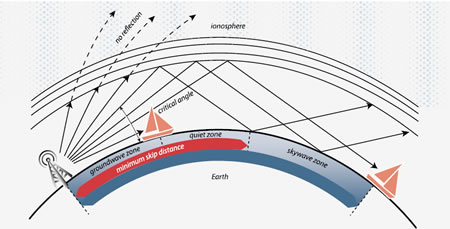
After several days of swearing at the machine and consulting every single “Idiot’s guide to marine SSB use…” or similarly titled literature, I gave up. I was realizing that our SSB equipment onboard is old, not really installed to-the-letter, and just plain wouldn’t work.
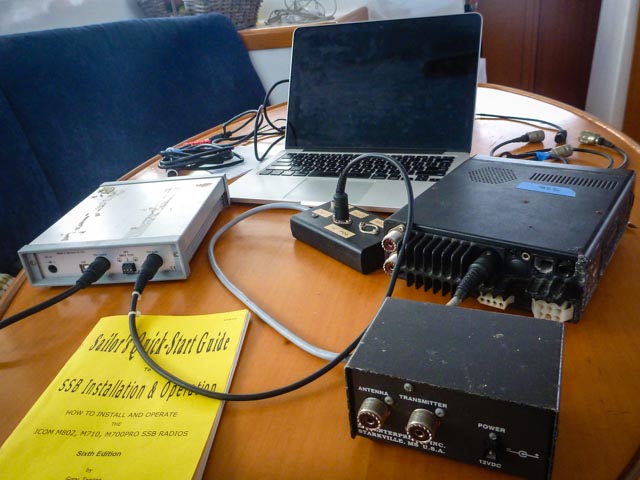
So I threw up a white flag and called in the experts. Gerry and Leo from Nautor Marine met us at the marina, dinghied out to Tayrona with us, and took a look at our set-up.
I knew it wasn’t great when they started out the conversation with, “you know with satellite phones and trackers from Spot and Delorme, you can get around having an SSB if you wanted….” Oh geez. Basically, our equipment was junk. The radio was old and probably didn’t work. The antenna and tuner were made for on land ham radio use (which just doesn’t work on a boat), and was horribly out of date. They ran down the prices to scrap and start fresh with a new system, and we kept our calm outside, but were both saying “OH SWEET JESUS, THAT’S EXPENSIVE!” on the inside. Amongst other expletives, I’m sure.
In the end, we decided that it was important for us to have an SSB on board, for weather and for communication with other sailors offshore, so we bit the bullet, bought the new parts, and we’ll be getting a new system installed in a few days.
THEN… there was some fun!! Pete’s Dad and his sister Liza came down to Florida officially to pick up the van we borrowed, but unofficially to go snorkeling, lobster fishing, and sailing with us. We bought lobster licenses, and gave it our best shot, but were eluded by the little crustaceans. But, we had blast out at anchor anyway!

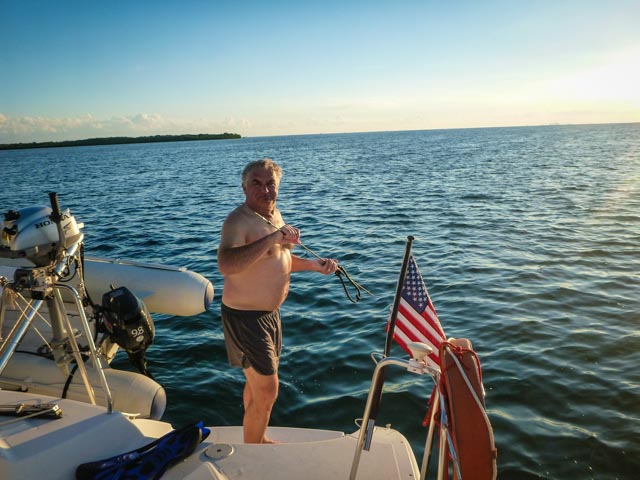
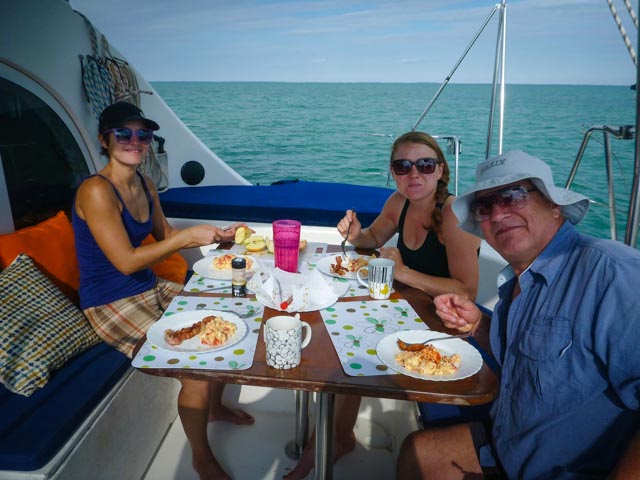
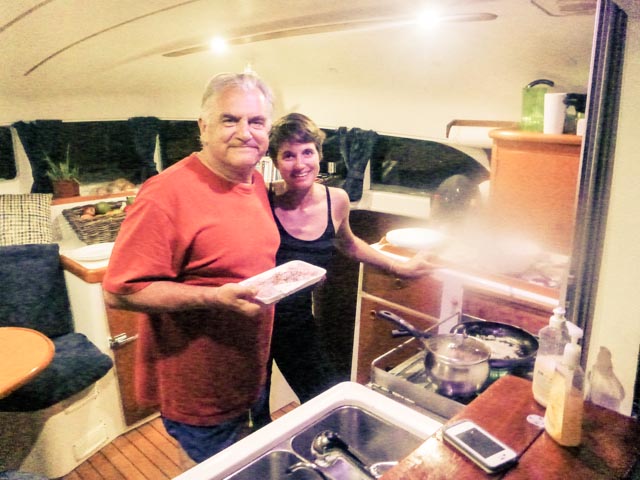

We even played around with the cast net one afternoon. This baby is one tricky beast.
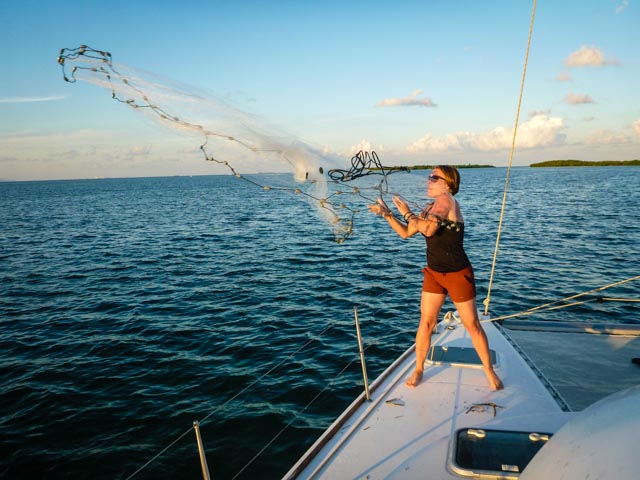
Had a few too many rainy, cloudy, stormy days, but such is the life of a sailor.

Since they left, it’s been back to the grindstone. In the last few days, we have:
- Installed both the new fridge and the new charge controller (yes those are Pete’s feet sticking out of the storage compartment).
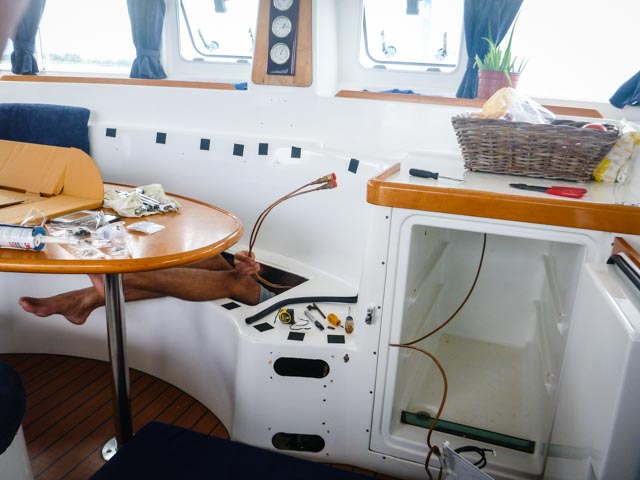
- Organized (or attempted to organize) the wiring around the boat. This has been a huge job, as doing things the quick way and the right way are two VERY different things when it comes to electrical work. Whoever first set up the wiring on our boat was a staunch proponent of the former option, over the latter, unfortunately for us.
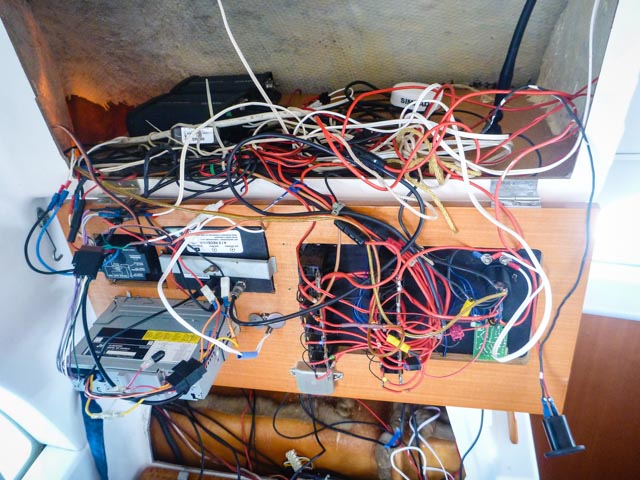
- Moved our VHF radio to a different spot in the nav station, in order to make way for our new SSB.

- Ordered countless parts to be replaced once they arrive in several months (do parts always take two months to arrive? Jeez…) and our loving family carries them down to us in their suitcases.
- Rewired all the solar panels in series, instead of parallel, as our new, fancy charge controller can handle a lot more voltage at any given time.

- Peeled off the old name stickers and replaced them with our own. Yay! Our boat finally says “Tayrona.”
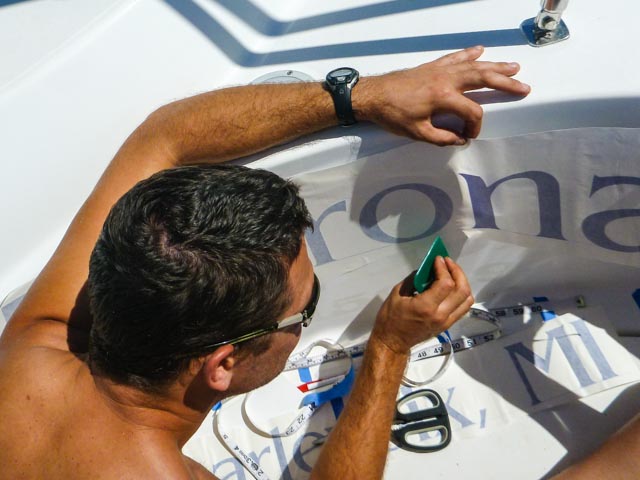
- Acquired all of our official documents from the coast guard, saying that, yes, we really do own the boat, and, yes, we can leave the country with it.
- Found that our boat does, in fact, come with a unit to plug into shore power, and wired that in.
- Spent a morning provisioning at the local big box store, filling our storage with nonperishables that’ll be much more expensive in the caribbean.
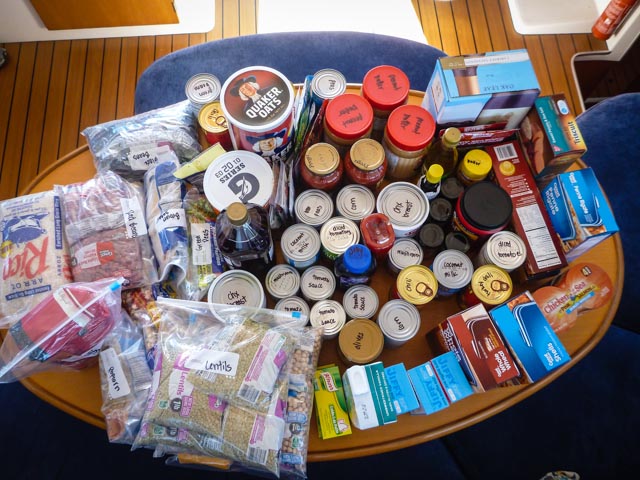
- Dug out an old wind/towing generator that came with the boat, and took it from being completely nonfunctional to producing an amp or two per day.
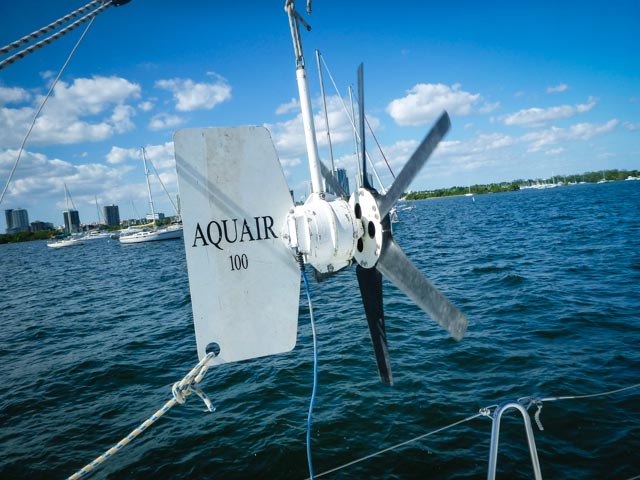
- Attacked the tedious list of items that showed up on our survey- adding valves where they should be valves, putting our batteries in battery boxes, bought new life jackets and flares… ect, ect.
Oh man… there’s no way I’ll cover all the little do-dads and do-hickies that we’ve had to buy, replace, or repair. It’s a darn good thing that both Home Depot and West Marine are in walking distance from the marina.
If I had to summarize, let’s just say that when it comes to a boat, there’s a lot to waterproof that doesn’t like to stay waterproofed, a lot that should be wired correctly and efficiently that generally isn’t, communication systems that go out of date faster than your iPhone, and plenty of previous owners who’ve left plenty of items to organize (why the heck did they put that here?), understand (what the heck does this thing do?), and clean up (seriously, if I find another screw hole drilled in this boat, I’m going to scream).
But, in the end, it’s been fun. I’m astounded each day by how much we are learning about our boat and about being a boat owner. We’ll get there. Just keep swimming, right?
